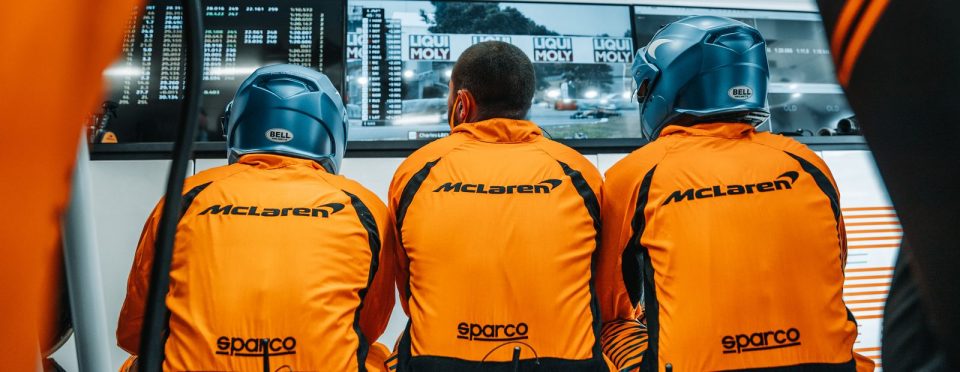Not quite sure why the McLaren cars ended up where they did at the Hungaroring? In the chaos of a wet-dry race you weren’t alone – but we can help with that.
Formula 1 teams tend to bristle with indignation whenever it’s suggested they enjoyed a slice of luck. The counter argument put forth is that a great deal of time and effort goes into ensuring the team is in position to capitalise on any opportunity. It isn’t good fortune if the car’s reliable; probability rather than serendipity guide the strategist’s calls, and a whole team behind the race engineer have a contingency ready whatever situation arises. Luck doesn’t come into it.
Everyone will, however, insist that sometimes they are very unlucky. On Sunday evening at the Hungaroring there was a quite a bit of that in the McLaren garage. Sometimes it just doesn’t go your way…
The race in numbers
| Carlos Sainz | Lando Norris | |
| Starting position | P9 | P8 |
| End of lap one | P8 | P13 |
| Finishing position | P10 (P9 after penalty for MAG) | P13 |
| Speed trap | 312.9km/h (4th) | 316.4km/h (2nd) |
| First pit-stop | Lap 3: 27.131s | Lap 4: 23.012s |
| Second pit-stop | Lap 40: 22.438s | Lap 35: 22.742s |
| Fastest lap | Lap 67: 1:19.457 (6th) | 1:19.945 (8th) |
The tyres

The driver’s compound strategy
The strategy… in theory
The weather forecast largely rendered strategy predictions moot: climatic conditions, and not pre-conceived plans, would be the primary decision driver on what was supposed to be a changeable afternoon.
Pirelli’s prediction of possible strategies for the 70-lap race was that the race would be a one-stopper, with the fastest way to the flag being an opening stint of between 35-40 laps on a Medium tyre, switching to a Soft tyre to the flag. The caveat with Pirelli’s predictions, however, is that they look at a car completing 70 laps in isolation, and the teams often have a different opinion, tasked with navigating the practicalities of a busy race track.
What actually happened…
Rain at lunchtime on Sunday left the track wet – but drying rapidly as the start approached. Teams have the choice of starting on Inters or Wets and, given the conditions, this was something all teams had to agonise over, as the track would dry between the laps to grid and the formation lap. Everyone lined up for the formation lap on Inters – except Kevin Magnussen, who had a full Wet on his car. He and team-mate Romain Grosjean pitted at the end of the formation lap and went directly to the Mediums.
We stayed out with Carlos stayed for three laps on the drying track before switching to Mediums. He ran those until lap 40, when we switched to Hard, and took those to the flag. Lando took a similar route. We stayed out a lap longer on his Inters, pitting for the Medium compound, and then coming in on Lap 35 for the Hard tyre.
The strategy… explained
The Hungarian Grand Prix at the Hungaroring has been a constant presence on the F1 calendar since 1986, and its defining feature is that it is very, very difficult to pass. Since F1 moved to Pirelli’s high-degradation tyres in 2011, the situation has eased, but it still remains a circuit where track position is a primary consideration. This makes it very different to the Red Bull Ring, where teams were happy to make pit-stops, trading track position for performance, safe in the knowledge that slower cars could be despatched in the DRS zones. In Hungary, the slower car you are stuck behind can be an obstacle for half the race. With this in mind, the guiding principal of strategy is to minimise the negative impact of track position, usually by minimising the number of pit-stops.
“On the laps-to-grid, the track had been in an Inter condition, and over the weekend it hadn’t been drying particularly quickly,” says McLaren F1 Head of Strategy and Sporting Randy Singh.
“By the time of the formation lap, the track had dried a lot. You could have pitted like the Haas’ did at the start of the race for the dry tyres. What they did was smart: they fell afoul of the regulations in terms of how it was executed but it was a good strategic decision because they were further back, so taking that risk was sensible and paid off in this case.
“For us, it didn’t make sense to risk on the track being dry enough. The big risk is that the car goes off and your race is over on the first lap. We were in decent positions and, like 16 other cars, decided to start the race on Intermediate tyres.”
Lando’s race went wrong at the start. He’d been surprised by the level of grip on the formation lap and misjudged his launch when the lights went out, getting a great deal of wheelspin and, effectively, standing still as other cars streaked past him. At the end of lap one, he had lost five places and was running P13. Lando shouldered the responsibility for that, ruefully saying that it was a great shame to have the bad start at the one circuit where you really can’t afford it.
The track was ready for slicks on lap three, but the team was uncomfortable with the idea of pitting both cars at the same time in what would be a busy pitlane (a decision vindicated by what happened to Carlos), and so they elected to stagger the stops, giving Carlos, as lead car, priority, bringing Lando in at the end of lap four, for Medium tyres.
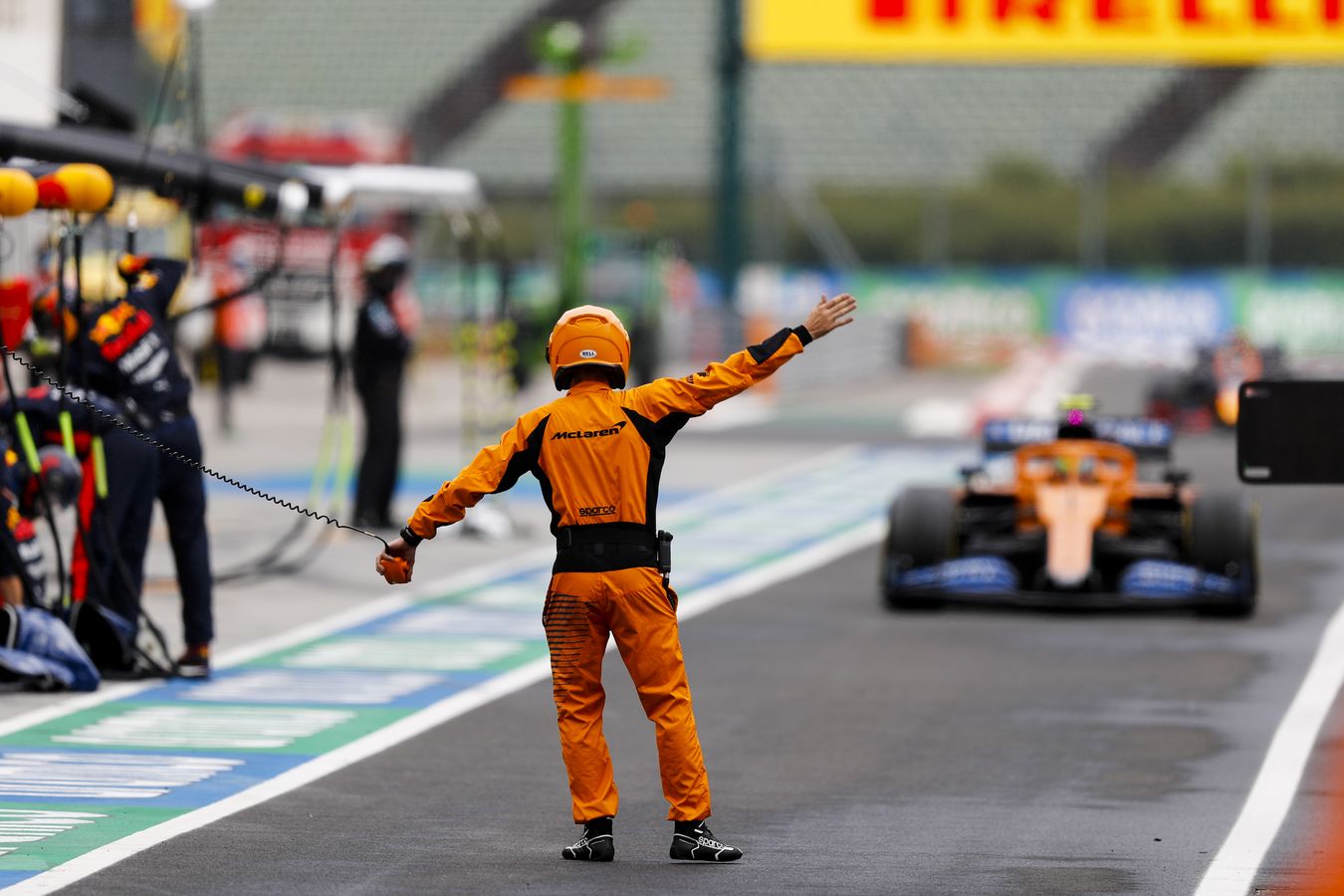
“In the first few laps, it was a case of deciding when was a sensible time to pit for dry tyres,” says Randy. “The decision is not leaving it so late that everyone can undercut you, but not going too early that you’re taking the higher level of risk from crashing on a low-grip surface.”
Once the order shook out, Lando had slipped back to P18, passed through the stops by Kimi Räikkönen, George Russell and Esteban Ocon, and by the Haas cars. If the race stayed dry, he would, in effect, now be running a slightly shortened but conventional strategy of two long stints on slicks. The expectation, however, was that more rain was on the way – probably to arrive between laps 25 and 30 – and that he would stay out on the Mediums until the rain arrived, and then pit onto whichever tyre the level of rain dictated – probably an Inter.
On lap 15, Lando passed Russell and gained another place when Pierre Gasly pitted off the Soft tyres. Lando would, however, spend most of the race from that point staring at the gearbox of Ocon.
Ocon pitted on lap 31 but Lando kept going, wanting to stay out until rain necessitated a stop. The expected arrival of the rain was first pushed back, and then, by around Lap 34, dissipated entirely, the radar suggesting the rest of the race would be dry.
“The first dry tyre stint was all about everyone trying to stretch their stints out,” says Randy. “On the Medium that is quite simple to do, but the Soft runners struggled. They had some small advantage of grip early in the stint, but we wanted to make sure we could get to the next rain shower without having to add an extra pit-stop. Nobody wanted to pit with the threat of rain around.
“The rain was initially expected to arrive at 15:45, then that went out to 15:50, 15:55 and finally 16:00 – but in the last two or three kilometres before it reached the circuit, the shower completely rained itself out. We realised fairly rapidly the rain wasn’t going to happen, and we quickly switched back into trying to optimise our positions in a dry race.”
Once that news arrived, Lando pitted immediately, on lap 35, to prevent Russell attempting an undercut. He emerged at half-distance on the Hard tyre, around 3.5s behind Ocon in P15. The pair caught and passed Grosjean 10 laps later, moving Lando up to P14, which is where he stayed until the final lap, where he used his slightly younger tyres to good effect, passing his long-time nemesis to finish P13.
Carlos was one of the cars that passed Lando at the start. He pitted at the end of lap three – and was unlucky. Half the field pitted on the same lap, and while his stop went well, he had to be held in the box while a stream of cars went by in the fast lane. Having been P8 after the end of lap one, when the order shook out, he had dropped to P12, passed by Daniel Ricciardo and Alex Albon through the stops, and the two Haas cars.
“You can predict that the pitlane will be busy – it’s one of the factors for not pitting both drivers on the same lap. However, it’s more difficult to predict which other cars will pit and the likelihood of being held for traffic which, in some cases, depends on their pit-stop times,” says Randy. “It was just really unfortunate that Carlos got held in the pit-stop because it was going to be tricky from there to make progress.”
Carlos had swapped to the Medium compound and, like Lando, we were planning one more stop for him if it stayed dry, but we were expecting more rain. He moved up to P11 on lap 20 when Charles Leclerc pitted off a set of Soft tyres onto Hards, on which he would have to complete 50 laps.
When the threat of rain went away, our considerations for Carlos were an immediate pit-stop in an attempt to undercut Ricciardo, four seconds ahead, or extend his stint to improve his chances of catching and passing Leclerc at the end of the race. With Ricciardo slightly out of reach, the decision was taken to extend his Medium run, giving him a shorter final stint and the maximum tyre advantage when he caught the Ferrari driver.
We eventually pitted Carlos on Lap 40, to ensure he didn’t fall back into traffic, taking on the Hard tyre. He emerged from the pits in P11, eight seconds behind Leclerc, and caught up to within DRS range by lap 46. Catching and passing, however, are two very different things, and following a thrilling wheel-to-wheel duel, Carlos made his advantage count to take the place on lap 60.
With good tyres to the end, he set about closing an 11-second gap to Magnussen over the last nine laps. He didn’t have quite enough time to make that work – though Carlos got close enough to ensure that a 10-second post-race penalty for the Dane, gave him ninth place. It wasn’t the high of the two races in Austria – but those two points in Hungary were as hard-fought as any we’ll ever earn and required every ounce of effort and strategic acumen the team possessed. It puts everyone in good heart as we head to Silverstone. Where we’d like a bit more luck.
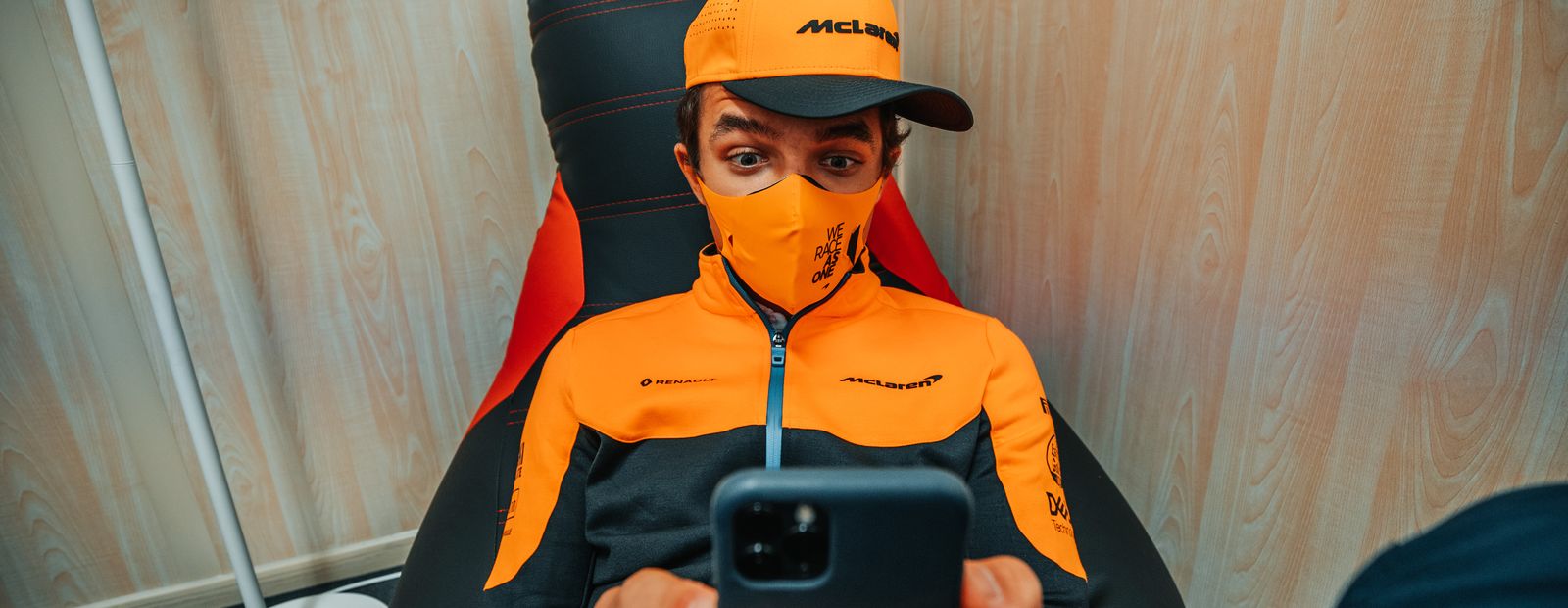
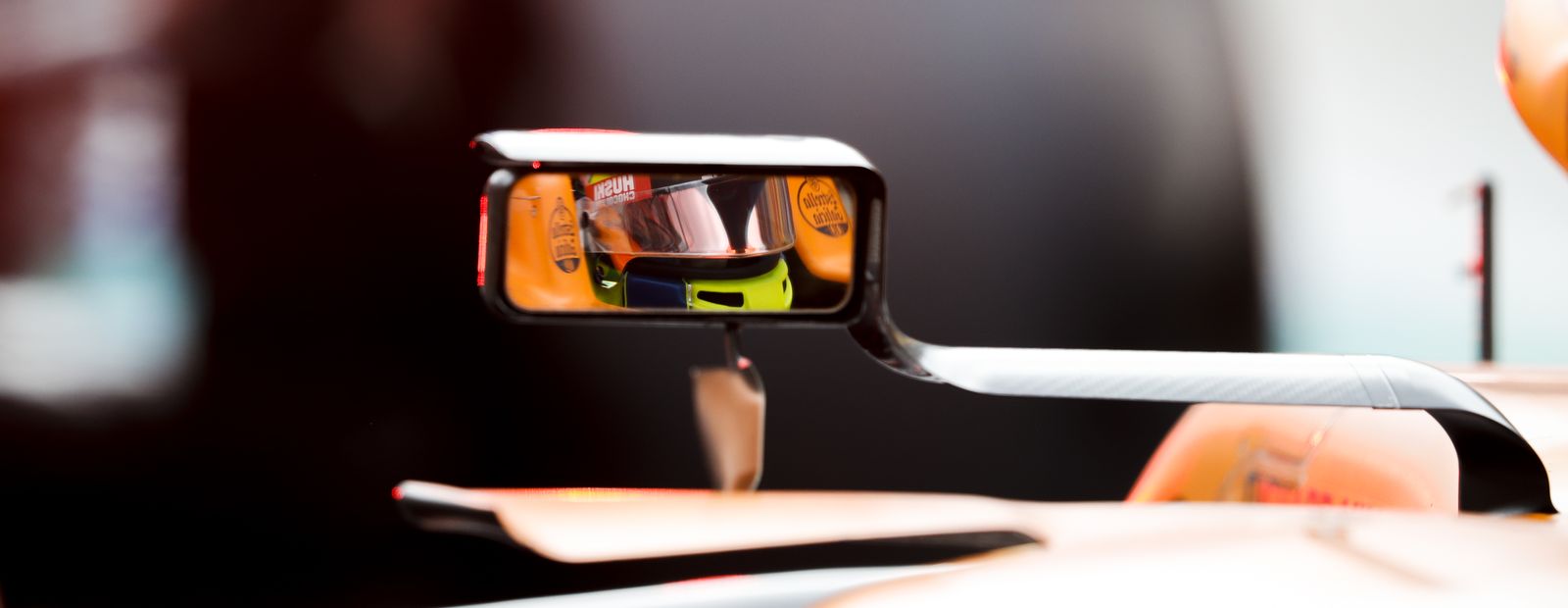
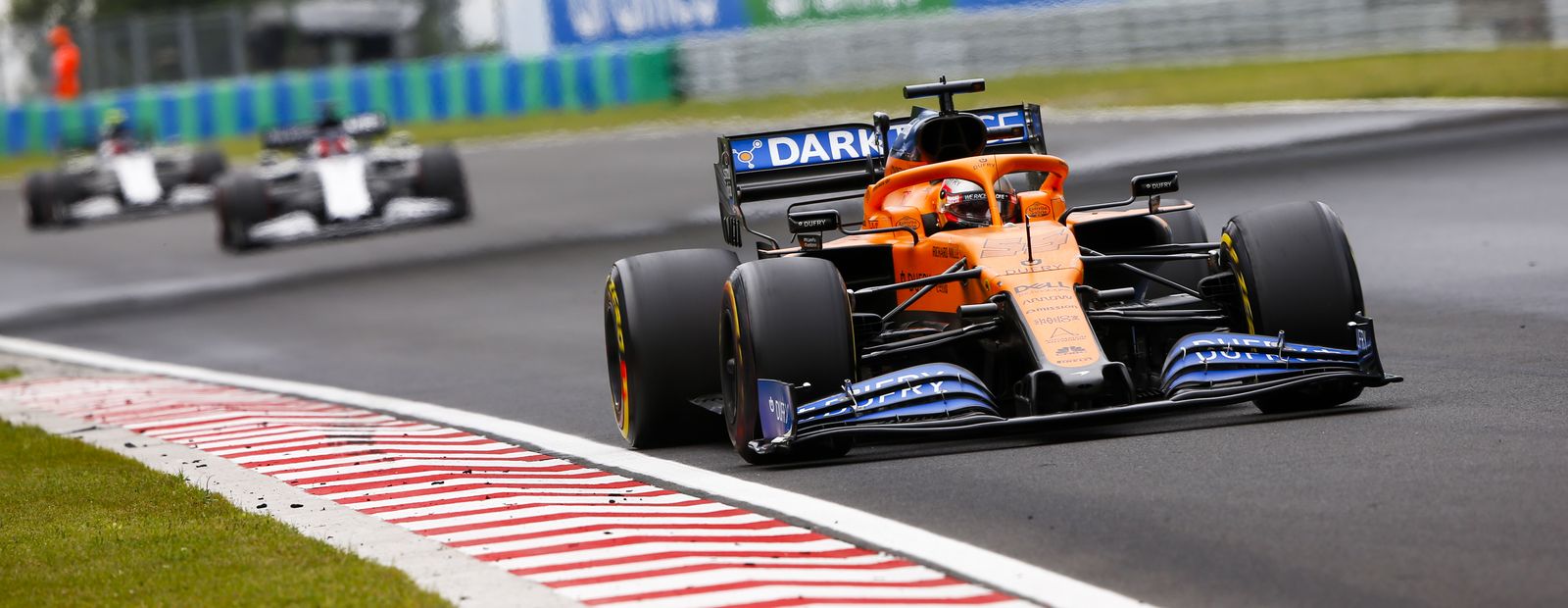
Hungarian GP race report
“Both drivers fought excellently, giving it their all right to the end and not giving up”
Join the team
McLaren Plus is our free-to-join fan loyalty programme, bringing McLaren fans closer to the team with the most inclusive, rewarding and open-to-all fan programmes in F1 & esports.
Sign up now, or current members can amend their details in the form below if necessary.


